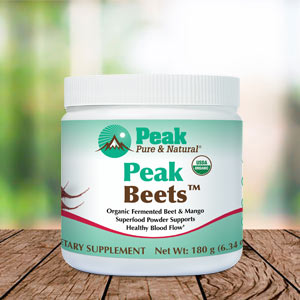Get Easy Health Digest™ in your inbox and don’t miss a thing when you subscribe today. Plus, get the free bonus report, Mother Nature’s Tips, Tricks and Remedies for Cholesterol, Blood Pressure & Blood Sugar as my way of saying welcome to the community!
Famed heart health booster blasts fat and diabetes

You may have heard of nitric oxide — a signaling molecule that acts as a natural vasodilator. That means it relaxes the inner lining of blood vessels to encourage smooth, oxygen-rich blood flow to every part of the body.
Nitric oxide — or NO for short — is important for maintaining healthy blood pressure levels and other cardiovascular functions. Research during the pandemic indicates it may also help the cells in your immune system react more quickly to invaders. And it plays a role in inflammatory responses and cognitive functions.
But that’s not all. According to new research, this chemical may help fight against certain conditions that set you up for cardiometabolic disease…
Nitric oxide could protect against obesity and diabetes
Cardiometabolic syndrome encompasses the conditions of metabolic syndrome but also includes symptoms and conditions, like inflammation and prothrombotic factors (blood clots), that lead to cardiovascular disease-related outcomes.
Dr. Jeonga Kim, leader of a recent study at the University of Alabama at Birmingham (UAB), says providing a sustained supply of nitric oxide may be an efficient way of treating cardiometabolic syndrome. That’s because reduced NO absorption is a hallmark of the disorder.
To put that idea to the test, his research crew used a sustained-release NO gel, developed at UAB, that releases a burst of NO in the first 24 hours after administration, followed by sustained NO release for four weeks, to improve symptoms of obesity and type 2 diabetes in mice fed a high-fat diet.
Researchers injected the gel into 8-week-old mice every two weeks for 12 weeks. Both the gel-injected mice and a group of control mice that didn’t receive the gel were fed a high-fat diet, which is known to lead to obesity and insulin resistance.
At the end of the 12 weeks, the mice receiving the NO therapy experienced improved glucose tolerance and lower fasting insulin and leptin levels. Leptin is a hormone that signals your brain you’re full.
And if that was not amazing enough, the NO mice gained 17 percent less body weight than the control mice. To be specific, researchers said the decrease was in body fat — not lean mass or water content.
But that’s only the beginning of the many ways that the NO gel went after body fat…
- The researchers saw increased mobilization of the enzyme hormone-sensitive lipase, which helps release the energy stored in fat cells.
- The fat cells in epididymal white adipose tissue became smaller. That fat is what constitutes the visceral fat that builds around organs. Visceral fat stimulates an immune response that increases your chances of heart attack, stroke, diabetes and early death.
- NO is known to increase a mechanism for the conversion of fat-storing white adipocytes (fat cells) to fat-burning beige adipocytes. In other words, the NO gel appeared to stimulate the browning of white fat cells. Brown fat produces heat to maintain body temperature in cold conditions and has been shown in studies to stimulate weight loss.
But the health benefits didn’t end there…
- The researchers observed a wide range of changes in certain measures of inflammation and metabolism in the NO mice. For instance, the expression of four inflammatory genes, including a marker for macrophages, was reduced in their visceral fat.
- The UAB’s NO gel also protected the mice against non-alcoholic fatty liver disease. The study determined this by recording lower liver weight, reduced triglycerides in the liver and reduced triglycerides and cholesterol in blood.
- In addition, the gel improved insulin sensitivity and cerebral blood flow. The mice receiving the gel showed significantly improved spatial learning ability, though it’s not known whether those changes were a direct effect of the NO therapy.
Natural ways to boost your nitric oxide supply
NO is naturally produced in the body through a process known as the dietary nitrate-nitrite-nitric oxide pathway.
When we eat foods containing natural dietary nitrates (not to be confused with sodium nitrite and sodium nitrate, used as food preservatives), they “react” with good bacteria or microflora on the tongue and are converted to nitric oxide in the gut, bloodstream and various organs.
Things like aging, mouthwash and a diet high in salt can impair your body’s ability to produce nitric oxide. So, a therapy like this gel could be a game-changer. Unfortunately, it’s probably years away from being available to us….
Luckily, it’s possible to boost nitric oxide in the body through diet — specifically with foods like beets and green leafy vegetables, like spinach.
Beets in particular have tons of the nitrates that your body converts into NO. One study showed people who drank beet juice showed a 25 to 50 percent increase in their breath NO levels.
If you’re worried you’re not eating enough of these foods, no worries. Like greens powders, beet powders have become increasingly popular since we’ve been learning so much about the valuable benefits of NO. These supplements are specifically formulated to naturally promote NO levels in the blood.
Editor’s note: Are you feeling unusually tired? You may think this is normal aging, but the problem could be your master hormone. When it’s not working, your risk of age-related diseases skyrockets. To reset what many call “the trigger for all disease” and live better, longer, click here to discover The Insulin Factor: How to Repair Your Body’s Master Controller and Conquer Chronic Disease!
Sources:
A novel therapy ameliorates obesity and Type 2 diabetes in mice fed a high-fat diet — University of Alabama at Birmingham
Subcutaneous Administration of a Nitric Oxide-Releasing Nanomatrix Gel Ameliorates Obesity and Insulin Resistance in High-Fat Diet-Induced Obese Mice — ACS Applied Materials & Interfaces
Nitric oxide and geriatrics: Implications in diagnostics and treatment of the elderly — Journal of Geriatric Cardiology
Healthy Foods to Boost Nitric Oxide — Nourish by WebMD














